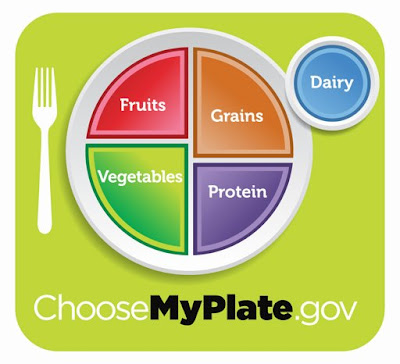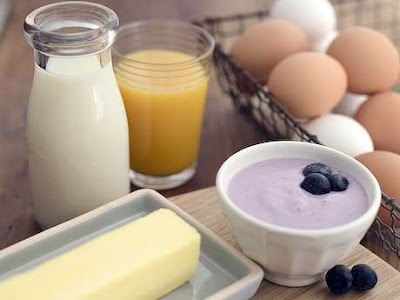Tweet
Came across this new buzz word in the world of nutrition numerous times on Facebook and Yahoo PH - MY PLATE. For someone who had several sessions with a medical nutritionist, the new paradigm got me interested and started to read more about it.
Ever since I was in Grade School, not too long ago, we have been taught about the FOOD PYRAMID as the ultimate guide to a well-balanced meal. That is the same lesson where we were taught GO (carbs and fats), GLOW (fruits and vegetables) and GROW (protein and dairy) foods.
 |
| (photo from Google) |
In the first week of June 2011, the US Department of Agriculture in consultation with First Lady Michelle Obama (who herself has launched a major food and health revolution in the US starting off by maintaining a beautiful poultry farm and fruit and vegetable garden at the White House lawn and her Let's Move campaign) has launched MY PLATE - a simple suggestion (not direction) for everyone on what a well-balanced meal should be.
 |
| In your plate: half should be fruit and vegetables (more of veg than fruit) and half are grains and proteins (more of grains than proteins) + 1 serving of dairy. |
Here is a sample of what a typical meal should be according to the US FDA.
 |
| Roughly 1 cup string beans, 1 orange (segmented), 1 slice wheat bread, 1 block tofu and 1 glass milk (GUTOM MUCH?) |
I think this visual diagram for portion control will work but here are some pointers to make this new eating habit work:
1. It is important how your food is cooked seasoned. Big calorie difference (between 100 - 300 calories) when food is fried vs being steamed. Poached chicken breast has less calories than beer battered fish.
2. Have variety - eating bread everyday or tuna every meal can give your tongue fatigue.
3. When eating outside (like a restaurant or at a party) - no need to finish everything on your plate.
4. Eat on time! It will keep you from food binging.
5. Calories in, calories out. When you feel like eating dessert or drinking alcohol and it's not on the plate, remember that you can burn it during any physical activity.
6. All bodies are different so it is still best to consult experts on the best nutrition and exercise program for you. :)
Here is a quick guide on food equivalents and substitutions on what 1 portion of something is (based on what my dietitian gave me). Remember that the food groups are additive when cooked together (i.e. using 1 portion cheese in the salad means using up your protein allowance).
PROTEIN:
 |
| Photo from Google |
1 Slice (6x2x1 inch) Fish
2 Tablespoons Crab meat / Lobster
5 pcs Hipon (shrimp) or 2 pcs Sugpo (prawns)
3 pcs small Pusit (squid) or large squid rings
1/3 cups shelled clams, snails, oysters (around 20 pcs)
1/2 cup monggo (mung beans or any legumes)
1/3 cup Cottage Cheese
1 Slice (6x2x1 inch) Veg G Meat
1/3 cup canned Tuna or Salmon in water
1 pc sardines in Tomato Sauce
1 pc chicken egg
1 slice cheddar cheese
1/2 cup tofu
1 hamburger patty (think Jollibee or McDo patty - not Champ or Quarter Pounder ha)
* avoid processed meats like hotdog, sausage, tapa, tocino, longganisa as the salt content is high and can retain water in the body
VEGETABLES:
 |
| Photo from Google |
Alugbati - Ampalaya - Baguio Beans - Bamboo Shoot - Banana Heart - Beets - Cabbage - Cauliflower Celery - Sayote - Cucumber - Eggplant - Gabi Leaves - Kangkong - Lettuce - Malunggay - Fresh Mushrooms - Mustard Leaves - Okra - Onion - Fern - Green Papaya - Patola - Pepper - Pechay - Saluyot
Sigarilyas - String Beans - Tomato - Upo - Carrots - Labong - Langkang Gulay - Togue - Singkamas - Squash - Asparagus
FRUITS:
 |
| Photo from Google |
2 pcs Dalanghita
2 pcs small Guava (pink)
1 slice Guyabano
1/2 pc green or yellow Mango
1 cup Strawberry
3 segments Suha or Pomelo
1 small Apple
1/2 pc large Banana or 1 small
1 pc Chico
10 pcs Grapes
3 segments Jackfruit
7 pcs Lanzones
5 pcs Lychee
1 slice Melon
1 small Pear
1 slice Pineapple
8 pcs Rambutan
1 pc Santol
5 pcs Sineguelas
1 slice Watermelon
1/3 cup any 100% Juice (unsweetened)
3 pcs Prunes
1/2 cup Buko
3 pcs Mangosteen
2 pcs Tamarind
DAIRY:
 |
| Photo from Google |
4 tablespoons Powdered Milk
1/2 cup Yogurt
GRAINS:
 |
| Photo from Google |
1 cup Lugaw (Porridge)
2 pcs Pan De Sal
2 slices Pan Americano / Tasty / Wheat Bread
1 pc Suman
1 pc Boiled Corn
1 cup Corn Flakes
1 cup Noodles / Pasta
1 pc medium sized Potato / Sweet Potato
3 pcs crackers (i.e. Sky Flakes)
2 cups plain unsalted Popcorn (no butter)
1 cup French Fries (not recommended)
My best estimate is that each My Plate serving is around 500-600 calories. Three (3) square meals and 2 snacks of grains in between will bring you right around the 2,000 calorie daily recommended intake. Think about it and see what little changes you can do to your eating habits to make this My Plate revolution a way of life and not a fad diet that will miraculously work for you only to go back on yo-yo.
My Plate photos courtesy of ChooseMyPlate.gov (visit them for more info)
Nice info Peri Peri French Fries
ReplyDelete